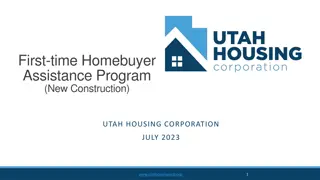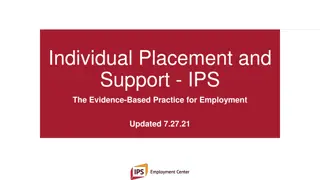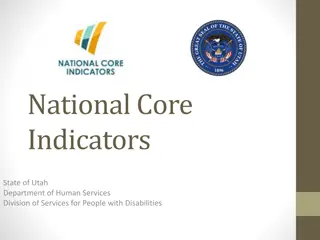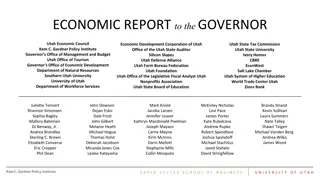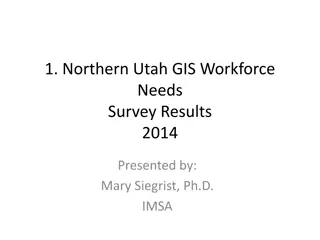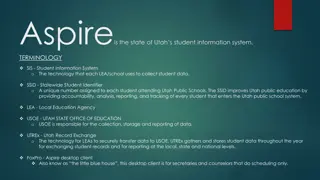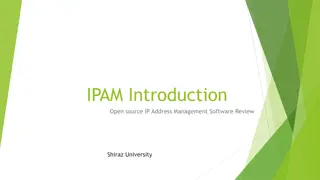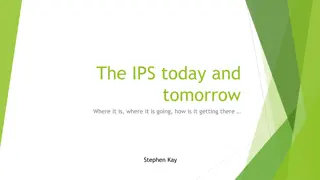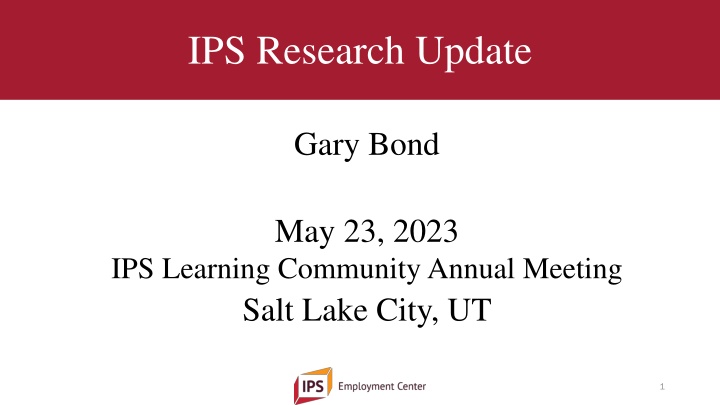
Recent Insights into IPS Research and Principles
Explore the latest updates on IPS research focusing on themes, principles, new populations, and innovations. Discover how matching client preferences and personalized benefits counseling can impact job tenure and earnings in IPS programs.
Download Presentation

Please find below an Image/Link to download the presentation.
The content on the website is provided AS IS for your information and personal use only. It may not be sold, licensed, or shared on other websites without obtaining consent from the author. If you encounter any issues during the download, it is possible that the publisher has removed the file from their server.
You are allowed to download the files provided on this website for personal or commercial use, subject to the condition that they are used lawfully. All files are the property of their respective owners.
The content on the website is provided AS IS for your information and personal use only. It may not be sold, licensed, or shared on other websites without obtaining consent from the author.
E N D
Presentation Transcript
IPS Research Update Gary Bond May 23, 2023 IPS Learning Community Annual Meeting Salt Lake City, UT 1
Three Themes in Recent IPS Research IPS Principles and IPS Fidelity New Populations Innovations 2
New Research on IPS Principles Open to anyone who wants to work Focus on competitive employment Rapid job search Targeted job development Client preferences guide decisions Individualized long-term supports Integrated with treatment Personalized benefits counseling
Matching Preferences Longer Job Tenure (Igarashi et al., 2022) At IPS enrollment, clients asked job preference in five areas: Occupation type Monthly income Weekly work hours Commute time Illness disclosure Number of Matches Out of 5 Areas
Personalized Benefits Counseling Increases Earnings After receiving specialized benefits counseling, Social Security disability beneficiaries increased mean annual earnings by $1200 (Tremblay et al., 2006) Observational study using matched sample of 1,926 VR clients with psychiatric disabilities (Kaya, 2023): Received Work Incentives Benefits Counseling Signif. Yes No % Competitively Employed (Successful VR Closure) 33% 29% p < .05
New Evidence for IPS Principles: Summary Matching client preferences (including all aspects of the job in addition to occupational preferences) increases job tenure Personalized benefits counseling increases earnings but has at best a small impact on employment rate (that is, the decision to start a job)
IPS Principles Needing More Research Integration with treatment: How do we achieve that with new populations? Individualized follow-up: How long, how to ensure warm handoff and long-term support plan?
IPS Fidelity Standard for Face-to-Face Community Contact Assumptions underlying Time in Community fidelity item: Employment services such as engagement, job finding, and follow-along supports provided in community settings. Most IPS specialist contacts are face-to-face, and mostly in the community, especially with employers and clients Online job searches not sufficient Job development involves building relationships with employers Contact with mental health professionals includes in-person weekly treatment team meetings
How Should IPS Provide Services? Impact of COVID Restrictions on IPS In NY: Reduced fidelity & initial dip in employment rate in March 2020, but quick rebound (Margolies, 2021) Norwegian study of 25 IPS specialists (Wittlund, 2022): Less collaborative engagement with employers and with clinical teams More virtual work-related meetings Since restrictions lifted, many IPS teams continued to rely on virtual meetings
Evidence Supporting the Importance of Community Contact Assertive community treatment literature has shown much higher rates of client engagement in services than office-based case management IPS study: Time in community correlated .82 (p < .01) with employment rate (N = 10 sites) (Becker, 2001)
% Time in Community Correlated with Better Employment Outcomes (Margolies, 2023) IPS teams with 20% or less contact time in the community had poorer employment outcomes % of IPS Sites with Good Employment in New York in 2019 (Margolies, 2023) 100% 85% 76% 80% 60% 41% 40% 20% 0% 20% or Less (N=37 Sites) Percentage of Time in the Community 21%-40% (N=34 Sites) 40% or More (N=13 Sites) 11
Community Outreach on High-Fidelity IPS Programs in Japan (Yamaguchi, 2020) High Fidelity Programs (N = 7) Low Fidelity Programs (N = 6) Community outreach and individual contact with clients associated with better employment outcomes Mean hours of service/month Outreach Individual contact Group meetings Outcomes Employed last 12 months Held job for 12 months 10.5 8.4 7.0 1.9 1.6 17.8 68% 59% 38% 21% 12
Importance of Face-to-Face Contact after Job Start (Bond & Kukla, 2011) Correlations for frequency of IPS specialist contact with job tenure for 142 clients after first job start: Face-to-face contact: 0.27, p < .05 Telephone contact: 0.01, ns
Importance of Face-to Face Community Contact: Current Evidence Community outreach to clients likely helps in the engagement process and probably reduces dropouts, but we need IPS-specific research Time in the community, with face-to-face meetings with employers and clients, may increase overall employment rate and job tenure Effectiveness of IPS of virtual counseling sessions and virtual meetings with other professionals untested
New Populations Traumatic Brain Injury Young Adults with Anxiety and Depression 15
IPS for Veterans with Traumatic Brain Injury (Pogoda, 2022) 12 VHA medical centers in US Administrative records for 2020-2022 92 veterans with traumatic brain injury (96% male) At baseline, unemployed for a median of 5 months Outcomes 51% gained employment Mean job duration was 3 months Disability rating did not correlate with employment! 16
Research on IPS for Young Adults Current Status Findings from a meta-analysis of 7 young adult studies: Positive employment outcomes for IPS: Overall employment rate: 58% for IPS, 32% for controls Small positive findings for education outcomes Most rigorous research on IPS for young adults has been in the first episode psychosis population But many other subgroups of young adults receiving IPS (Bond et al., 2023) 17
Australian IPS for Young Adults (Simmons et al., 2023) IPS teams in two headspace centers in Melbourne Sample consisted of 326 young adults (ages 15-25) 80% had a diagnosis of depressive or anxiety disorder or other nonpsychotic disorder Fair to good IPS fidelity Peer worker provided vocational support to 116 (36%) participants requiring additional support 18
Australian IPS for Young Adults: Outcomes (Simmons, 2023) 195 (60%) of young adults achieved a competitive job working 15 hours or more per week 55% of jobs sustained for 26 weeks Young adults with peer support had similar outcomes as those not needing it 19
US Study of IPS for Young Adults (Albdulmunem, in press; Bond, in press) Study conducted from March 2020 to June 2022 9 IPS programs in 5 learning community states (CA, KY, MN, SC, WI) 111 young adults (ages 16-24) enrolled and followed up until termination or one-year follow-up Fidelity reviews completed using IPS-Y: Adaptation of standard fidelity scale for young adults 20
Characteristic Characteristic N (%) N (%) Gender Psychiatric Diagnosis Depressive disorder Anxiety disorder ADHD PTSD Schizophrenia spectrum 16 (14.4%) Substance use Bipolar Autism IPS for Young Adults Participant Characteristics (N=111) Female Male Other 59 (53.2%) 47 (42.3%) 5 (4.5%) Mean = 19.2 26 (23.4%) 53 (47.2%) 32 (28.8%) 66 (59.5%) 43 (38.7%) 26 (23.4%) 20 (18.0%) Age 16-17 18-20 21-24 14 (12.6%) 12 (10.8%) 10 (9.0%) Race White 55 (49.5%) Housing situation Living with family/caregiver Black 29 (26.1%) 71 (64.0%) Hawaiian/ Pacific Islander 3 (2.7%) Private residence 26 (23.4%) Native American 1 (0.9%) Homeless 5 (4.5%) Biracial/ Multiracial 6 (5.4%) Other residential setting 9 (8.1%) Not reported 17 (15.3%) Marital status Never Married 109 (98.2%) Ethnicity Married/Living as married 21 Hispanic/Latino 20 (18.0%) 2 (1.8%)
IPS for Young Adults: One-Year Outcomes (N = 111) Mean program retention: 5 months Gained employment: In education during follow-up: 40 (36%) Began new education program: 14 (13%) Employed and/or education: 76 (69%) 51 (46%) 22
Employment Outcomes for Worker Sample Among Workers (N=51): Time to First Job Earnings Time Worked Hourly Wage Mean 3 months $7,028 5 months $12.22 23
Innovations People with lived experiences providing IPS (Cook) Work-focused Cognitive Behavioral Therapy 24
Effectiveness of Peer-Provided IPS (Cook et al., 2022) Peer-run organization provided two types of supported employment services: IPS and Choose-Get-Keep IPS team achieved good fidelity Choose-Get- Keep (N=164) 21% 18% Competitive Employment Outcomes IPS Signif. (N=184) 43% 38% Overall Employment Rate Monthly Employment Rate p < .001 p < .001 25
Work-Focused Cognitive Behavioral Therapy (CBT) Added to IPS (Kukla et al., 2019) Standard IPS is not successful for all clients This pilot offered 12-sessions of CBT for 44 veterans who had remained unemployed on average for a year after enrollment in IPS After receiving work-focused CBT along with IPS: 75% worked over 6-month follow-up 52% were steady workers (worked at least 3 months) 26
Conclusions Regarding IPS Innovations People with lived experience can deliver IPS at high fidelity and achieve better employment outcomes compared to using a non-evidence-based service model Work-focused cognitive behavioral therapy may be a useful adjunct for some client subgroups, such as: Workers on sick leave returning to an existing job Randomized controlled trials needed 27
Overall Conclusions IPS principles have held up well over the three decades since Becker and Drake developed IPS IPS also continues to evolve, with expansion to new populations and testing of innovations The COVID pandemic led to widespread adoption of telemedicine. We need to rigorously evaluate the effectiveness of IPS services delivered remotely. 28



